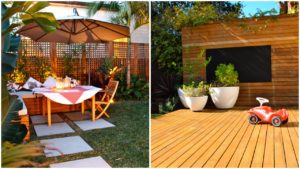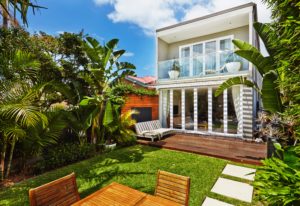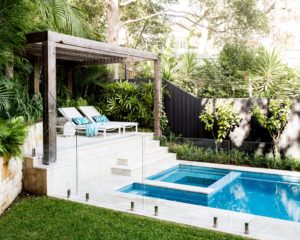
Inside Out August 2016
How to design a garden that’s functional for the whole family as well as safe (and fun) for kids?
It comes down to some smart thinking about materials, layout and even which grass and plants you use. Inside Out asked Growing Rooms Landscape’s designer and company director Oliver to share his top tips, along with images from a Sydney garden he designed with kids in mind.
What are the considerations when planning the layout of a family garden?
The age of the children is usually a main consideration as it affects the location of play spaces and proximity to the house. Younger children need constant supervision so it’s best if they are visible at all times and closer to the house. This enables the adults to enjoy themselves without having to constantly check up on the kids. If the kids are older, they may appreciate a bit of space, with their own semi private corner of the garden that can feel like their own. We always try to maximise lawn space and keep play areas separate from hard surface corners. For peace of mind, play spaces need to be enclosed and out of view from public walkways or roads.
What grasses do you recommend to withstand playtime?
We most often use ‘Sir Walter’ buffalo due to its versatility and its availability. It is soft leafed, can handle shade and will tolerate regular wear and tear. Matilda buffalo is similar but harder to find, with very good wear resistance and recovers well.
Alternatively, if you have a lawn space in full sun, Kikuyu has an attractive texture and handles traffic very well. It does however require a fair amount of maintenance to keep it looking its best.
Empire Zoysia is another turf for full sun, but with minimal maintenance needs. It has a soft, fine texture and handles reasonable wear. However it is slow growing and therefore takes longer to regenerate if it is damaged. Zoysia is suited to a warmer climate and not ideal in Melbourne.
 Are there any plants to avoid if small children will be using the garden?
Are there any plants to avoid if small children will be using the garden?
Obviously plants with thorns and spines are best avoided, at least in reachable areas. Some plants, for example some ornamental grasses, can have sharp or irritating leaves. Some are poisonous if ingested, they may be common plants that you wouldn’t expect eg, Oleander, Euphorbia, Angels Trumpet, many types of lilies. If you’re unsure, just check with a horticulturalist at your local nursery before planting. Some plants attract mosquitos so you may choose to avoid those – for example shade-loving, bold-leafed tropical and bromeliads.
Delicate plants such as succulents aren’t recommended, as they are likely to be damaged.
What hard surfaces work best with children?
Ultimately the safest surfaces are ones with the greatest impact absorption, for example bark chips, sand or lawn. But outside of a play area these aren’t ideal. Decking is going to absorb impact a bit better than paving or concrete, but can get slippery if algae is allowed to build up so it’s important to keep it clean. Decking holds the warmth better in winter but also gets hotter in the sun. No hard surface is ideal as a play surface but decking is probably the better choice for winter when the lawn is wet and boggy.
 What’s your advice on cubby houses?
What’s your advice on cubby houses?
Get creative! To all the home DIY enthusiasts, this can be just as fun for you as your children! What storybooks do you read to them? Do they like medieval or fairytale castles? Or pirate ships? Be gender specific to create greater appeal.
Practically speaking, follow online instructions, sand down corners and edges and use screws rather than nails, making sure none are piercing through the timber. Ideally place your cubby in a bright location to avoid it becoming home to spiders. Check it periodically for hazards. If it’s not been used for a while it may need spraying for insects. If you would rather buy a kit make sure you buy from a reputable brand, and that non-toxic paints and stains have been used.
Are there other ways to include a sense of play in a garden?
My clients love play features that can be concealed or packed away out of sight. Building a sandpit into a deck with a lid is a great way to get two uses from the same space. Colourful and textural planting is exciting and playful. Using log rounds or small boulders as a stepping stone path through a garden bed to create a sense of adventure.
Read the full article HERE.
More pictures of this beautiful child-friendly garden are displayed in our Portfolio.
What are your top tips for a child friendly garden?





